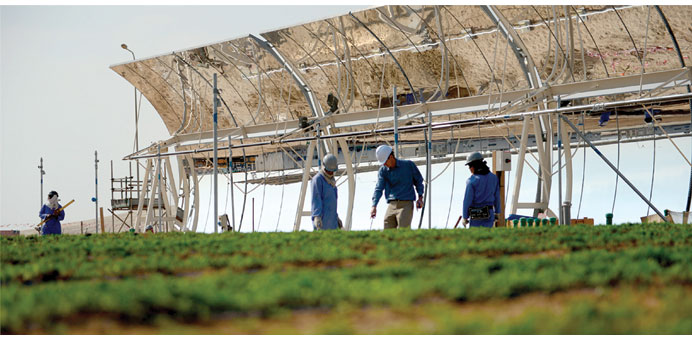WHERE THERE’S HOPE: Sahara Forest Project is an impressive and ambitious development, and if successful could have a large impact on the source of food in Qatar.
By Steff Gaulter
There’s certainly no disputing the fact that Qatar is a desert. Doha receives just 75mm (3 inches) of rain per year and to be classed as a desert there needs to be less than 250mm (10 inches) of rain.
It’s clearly a dry place, but despite this, when you drive around much of the country, there are still a few plants and trees dotted around the landscape.
Plants that can survive with so little rain are quite impressive, but generally they are decorative. With such asporadic rainfall not many food-bearing plants can exist naturally. Food-bearing plants tend to need far more water, and that water needs to be provided regularly.
Also working against the plants is the issue that the soil in Qatar is really very sandy and not the most fertile. The fertility of soil generally depends on organic material that lies in it, the old leaves and dead bugs. The organic material forms molecules that provide nutrients to living plants and animals. As the soil in Qatar doesn’t contain much organic matter, it therefore isn’t very fertile either.
Despite both the lack of rain and the quality of the soil, the National Food Security Programme is aiming to make Qatar 70% self-sufficient by 2023. It is certainly an ambitious project, but in other parts of the globe, desert land has already become extremely productive.
The San Joaquin Valley in California has been transformed into valuable farmland, with crops of raisins, cotton and nuts flourishing on the valley floor. What these landscapes lack in terms of fertile soil, they can make up for in terms of longer growing seasons.
Hot deserts are in parts of the world with sunny climates so don’t have the cool winters, short days and endless rain that they might have if they were situated further from the equator.
The main deterrent against growing endless plants in the desert is the extortionate cost of water. In Qatar, we use desalinated water, which is the most expensive water there is.
In California, they divert water from the rain-rich north to the barren south to irrigate the crops. In Qatar, of course, there is no possibility of relocating water, but maybe there is a way of growing plants which uses substantially less water.
Hydroponics is a way to grow plants without soil. The nutrients that a plant needs are dissolved into water instead and this is directly absorbed by the roots. This uses only ten percent of the water required in conventional agriculture, because rather than the water running into the soil and flowing away, in a hydroponic system the water can be reused and recycled.
This also ensures that any fertilisers that are used can be contained and don’t find their way into rivers or lakes, and therefore into our water supply.
As well as being far more water efficient, there are other advantages in hydroponics. The plant no longer has to waste energy developing a huge root system to look for nutrients. Instead all the necessary nutrients are delivered straight to the plant.
This has two main benefits. Firstly, it means the plants have smaller roots, so can be planted closer together, ensuring a higher yield from less space. Secondly, it means that the plants can concentrate on growing flowers, fruit or vegetables, rather than roots, so the plants grow faster and produce more.
This means that hydroponics is highly beneficial in parts of the world where space is at a premium: it can even be used on roof tops or greenhouses.
In Qatar, of course, there is still the hurdle of water being expensive, but what if you could use solar energy of the sun to generate power for the desalination plants? This would surely mean that hydroponics would be feasible in this country.
This vision is not as futuristic as you might think. The other day I was at a friend’s house when he brought out an enormous bag of cucumbers, and they were no ordinary cucumbers either. They had been grown using hydroponics and the water used for irrigation was generated by solar power.
The company behind all the cucumbers is called the Sahara Forest Project, which has a farm near Mesaieed. At the moment it’s just a pilot site, and cucumbers are the perfect vegetable to experiment with as they only take two weeks to grow. The technology within the site is impressive to say the least.
To generate the desalinated water, the plant uses concentrated solar power, a method of using mirrors to concentrate the energy from the sun. This creates temperatures high enough to drive turbines and generate electricity. For desalination, which requires both electricity and high-temperature water, concentrated solar power is ideal.
The project aims towards a method of operation which produces zero waste, so as you might expect, the project also has a way of dealing with most of its byproducts. After extracting potable water, desalination produces a vast quantity of concentrated salty water, known as brine.
In the clever project in Mesaieed, even this is not wasted. The saltwater is used to cultivate sea-loving plants, halophytes, as well as algae, which could be used for large-scale bio-energy production.
The Sahara Forest Project is clearly an impressive and ambitious development, and if successful could have a large impact on the source of our food in Qatar. In the next few years we are likely to see more and more fruit and vegetables in the supermarkets that were grown in Qatar.
Whether or not you are impressed by the technology behind the scenes, with less time between being picked and being eaten, it can only be a good thing for our taste-buds!
(The author is Senior Weather Presenter at Al Jazeera English channel. She can be contacted on [email protected] or on Twitter at @WeatherSteff)



